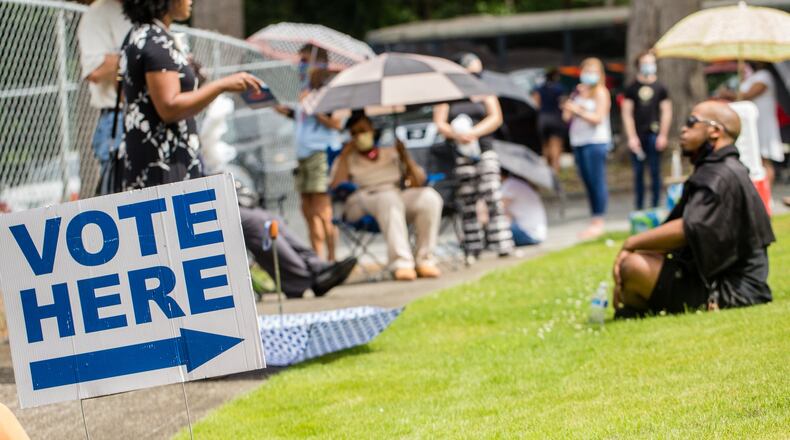When election officials mailed absentee applications to nearly 7 million Georgia voters, they responded in droves.
Absentee voting rates skyrocketed, from 6% of all ballots cast in the 2018 general election to over half of the votes cast in this month’s primary. A record 1.1 million voters cast absentee ballots in the primary, avoiding human contact during the coronavirus pandemic.
Voters won’t have the same easy access to absentee voting again.
Secretary of State Brad Raffensperger, who started the absentee ballot request program in April, decided against mailing ballot applications to voters for the presidential election, when turnout is expected to reach a new high of 5 million. He said it would be impractical and too expensive to repeat the effort this fall.
Instead, Raffensperger plans to create a website where voters can request absentee ballots on their own. All registered voters are eligible to cast absentee ballots.
The move is likely to reduce requests for absentee ballots.
Fewer absentee voters would mean more people at crowded precincts, raising the possibility of another maddening election for voters who had to wait in line for hours in some precincts for Georgia's primary.
“The absentee numbers came from it being more convenient,” said Janine Eveler, the elections director for Cobb County, where almost 107,000 voters returned absentee ballots, the most of any county in the state. “When we’re not sending them an application, it won’t be as convenient and they’ll go to the polls again.”
Raffensperger’s office declined to grant an interview or answer emailed questions. His office wouldn’t explain how election officials can accommodate more in-person voters in November with a less robust absentee voting effort.
It was necessary to send absentee ballots before the primary because of COVID-19, Raffensperger told state legislators during a hearing last week. The program strained county election offices and cost an estimated $5 million, but the secretary of state's office wouldn't provide an exact figure.
“We need to see more people early vote and absentee vote, but trying to do it through a manual paper absentee ballot application that needs to be mailed in would be next to impossible with the manpower and ability for most counties to handle,” Gabriel Sterling, the implementation manager for Georgia’s voting system, said during the hearing.
In some ways, the absentee ballot effort was a victim of its own success.
So many voters responded that election officials struggled to handle the load. Some voters waited weeks to receive their ballots; others never got them at all.
Raffensperger’s solution to those problems — his upcoming absentee ballot website — will require voters to take the step of going online rather than returning the pre-filled paper form they received in the mail for the primary.
“Sending an application to everyone in advance was a good idea. They auto-filled the information and tried to make it as friendly as possible,” said Amber McReynolds, the CEO for Vote At Home, an organization that supports voting by mail. “What they didn’t do is they really need a ballot-tracking solution so voters know the status of their ballot.”
Voters, especially in Fulton County, added to lines during the primary when they didn't receive their absentee ballots. County election officials had difficulties processing so many more absentee ballot applications than they ever had before.
“We tried to do an absentee ballot. It didn’t show up,” Jackie Chang said after voting at Park Tavern in Piedmont Park, where 16,000 registered voters were assigned.
Naomi Donaldson gave up on voting after waiting in line for almost three hours without casting her ballot at Cross Keys High School in DeKalb County. She requested an absentee ballot in April but never received it in the mail.
“There was a feeling of helplessness, and there’s no advocate for us,” Donaldson said.
About 97% of Georgia voters who requested absentee ballots received them from the state’s mailing company by election day, according to U.S. Postal Service tracking data reported by the secretary of state’s office. The remaining 3% arrived late, weren’t scanned by the Postal Service or got lost in the mail. Those figures don’t account for absentee ballot applications that were never processed by county election offices.
The sharp increase in absentee voting caused problems for election officials who had to process large amounts of mailed ballots — and for voters who couldn't track when their absentee ballots would arrive, said Kim Stancil, the elections director in Cherokee County. The secretary of state's office tracked ballot mailing progress, but that information wasn't available to voters through the state's My Voter Page.
Voters who didn’t receive their absentee ballots in time showed up at precincts, further clogging lines. Poll workers had to call into county election offices to cancel their absentee ballots before they could vote in person.
“Our phones never stopped ringing, and it was 90% canceled absentee ballots,” Stancil said.
The upcoming absentee ballot application website will prevent the kind of paperwork and data-entry problems that plagued county election offices in the primary, Sterling said. Voters will still be able to mail absentee ballot requests.
Raffensperger, a Republican, had already announced he would discontinue the absentee ballot request mailing program before a bill introduced in the state House last week sought to prohibit election officials from sending absentee ballot applications to voters. That bill failed to pass.
Of voters who returned absentee ballots in the primary, more submitted Democratic than Republican ballots.
About 600,000 voters cast Democratic ballots, 524,000 used Republican ballots and 26,000 voted a nonpartisan slate. Georgia is an open primary state, meaning voters can choose which party’s ballot they want to use without having to register with a party.
Democrats also outpaced Republicans at in-person voting locations, 609,000 to 504,000 in the U.S. Senate race. The secretary of state’s office hasn’t released full turnout figures.
Without the government mailing absentee ballot applications to all voters, political parties and advocacy groups might do so instead.
“Since the secretary of state won’t do his job and help every Georgia voter exercise their option to vote by mail, the Democratic Party of Georgia is looking into all options to help voters get ballots easily, including directly mailing ballot request forms to voters,” said Maggie Chambers, a spokeswoman for the Democratic Party.
A spokesman for the Georgia Republican Party didn’t return a phone call seeking comment.
Raffensperger has said he will ask community organizations to provide space for more precincts and encourage early voting before the November election, both at in-person locations and with absentee ballots.
Georgia election calendar
July 20: In-person early voting begins for primary runoffs
Aug. 11: Primary runoff election
Oct. 5: Voter registration deadline for general election
Oct. 12: In-person early voting begins for general election
Nov. 3: Election Day
Dec. 1: Runoffs for state and local offices
Jan. 5: Runoffs for federal offices
About the Author
Keep Reading
The Latest
Featured



